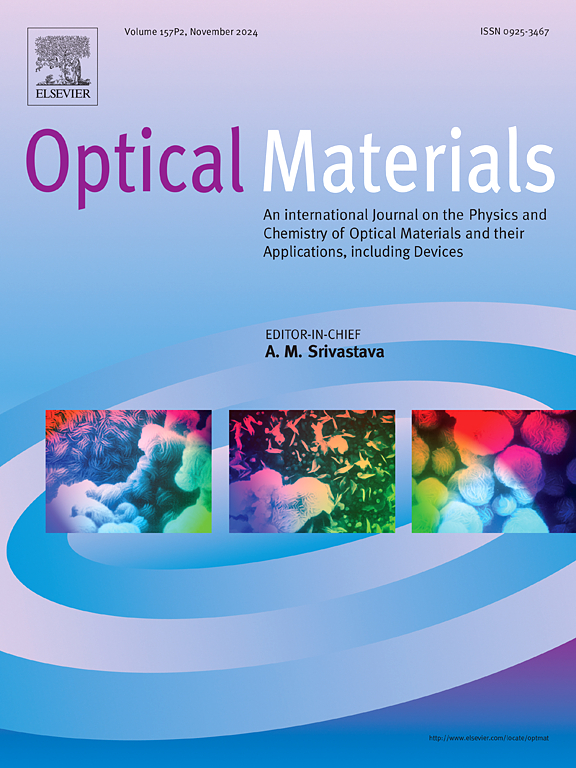探索各种改性剂对氧化锌基硼碲玻璃系统结构、物理和机械性能的影响,以提高辐射屏蔽性能
IF 4.2
3区 材料科学
Q2 MATERIALS SCIENCE, MULTIDISCIPLINARY
引用次数: 0
摘要
这项研究旨在利用熔体淬火技术制造含有各种改性剂(包括氧化钼、氧化铋和氧化铅)的锌硼碲玻璃(ZnO-TeO2-B2O3)体系。共生产了四种玻璃样品,每种样品都含有占纯净玻璃体系总重量 20% 的特定改性剂。每个玻璃样品都有一个代码:TBZn、TBZMo、TBZBi 和 TBZPb。XRD 结果显示,所有玻璃样品均为无定形。傅立叶变换红外光谱结果显示了硼酸盐和碲氧化物的官能团。当添加不同的氧化物而不是氧化锌时,机械性能会降低。例如,玻璃样品的杨氏模量降低了;TBZn、TBZMo、TBZBi 和 TBZPb 的杨氏模量记录值分别为 74.516、72.569、60.526 和 59.272 GPa。另一方面,添加 Bi2O3 和 PbO 可增强屏蔽性能。例如,TBZn、TBZMo、TBZBi 和 TBZPb 在 0.015 MeV 的线性衰减系数值分别为 168.739、115.656、380.711 和 279.162。此外,TBZn、TBZMo、TBZBi 和 TBZPb 在 5 厘米和 600 千伏的辐射防护效率(RPE)分别为 83.220%、79.299%、93.919% 和 90.222%。虽然添加不同的氧化物会降低现有玻璃的稳定性,但同时也会增强它们的屏蔽性能,因此建议将它们用于辐射屏蔽领域。本文章由计算机程序翻译,如有差异,请以英文原文为准。
Exploring the diverse modifiers influence on the structural, physical, and mechanical properties of a zinc oxide-based boro-tellurite glass system for enhancing radiation shielding performance
This work is meant to fabricate zinc boro-tellurite (ZnO–TeO2–B2O3) glass systems with various modifiers, including MoO3, Bi2O3, and PbO, using the melt quench technique. Four glass samples were produced, each comprising 20 % of a specific modifier from the total weight percent of the neat glass system. Each glass sample is given a code: TBZn, TBZMo, TBZBi, and TBZPb. The XRD results showed an amorphous nature for all glass samples. The FTIR results showed the functional groups for borate and tellurite oxide. The mechanical properties were reduced when different oxides were added instead of ZnO. For example, Young's modulus decreased for glass samples; their recorded values for Young's modulus are 74.516, 72.569, 60.526, and 59.272 GPa for TBZn, TBZMo, TBZBi, and TBZPb, respectively. On the other hand, adding Bi2O3 and PbO led to enhanced shielding properties. For instance, the linear attenuation coefficient values for TBZn, TBZMo, TBZBi, and TBZPb at 0.015 MeV are 168.739, 115.656, 380.711, and 279.162, respectively. Also, the radiation protection efficiency (RPE) at 5 cm and 600 keV is 83.220 %, 79.299 %, 93.919 %, and 90.222 % for TBZn, TBZMo, TBZBi, and TBZPb, respectively. While adding different oxides decreased stability in the current glasses, it also enhanced their shielding properties, recommending their use in the radiation shielding field.
求助全文
通过发布文献求助,成功后即可免费获取论文全文。
去求助
来源期刊

Optical Materials
工程技术-材料科学:综合
CiteScore
6.60
自引率
12.80%
发文量
1265
审稿时长
38 days
期刊介绍:
Optical Materials has an open access mirror journal Optical Materials: X, sharing the same aims and scope, editorial team, submission system and rigorous peer review.
The purpose of Optical Materials is to provide a means of communication and technology transfer between researchers who are interested in materials for potential device applications. The journal publishes original papers and review articles on the design, synthesis, characterisation and applications of optical materials.
OPTICAL MATERIALS focuses on:
• Optical Properties of Material Systems;
• The Materials Aspects of Optical Phenomena;
• The Materials Aspects of Devices and Applications.
Authors can submit separate research elements describing their data to Data in Brief and methods to Methods X.
 求助内容:
求助内容: 应助结果提醒方式:
应助结果提醒方式:


